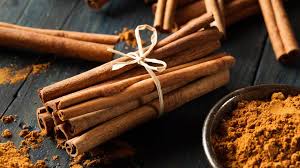
As we are in December, let’s learn about a festive spice – cinnamon!
Cinnamon was spoken of in the Bible as “one of the finest spices”. The Ancient Egyptians used it in the embalming process, and it used to be traded as a currency. In Ancient Rome, weight for weight, cinnamon was five times more expensive than silver!
Cinnamon’s beautiful smell and flavor come from the essential oil in the bark. Importantly, it has multiple health benefits – anti-viral, anti-bacterial, anti-fungal, anti-inflammatory, and possibly anti-cancer. It is good for regulating blood sugar and human trials suggest that it is helpful for people with diabetes.
Cinnamon has been used for years as an home remedy to relieve indigestion. A study from RMIT University School of Engineering in Melbourne, Australia found that cinnamon appeared to protect the walls of the stomach and small intestines.
Finally, as we know, one of the biggest health problems today is chronic inflammation. So it is wonderful to read in a 2015 study in Food & Function, researchers reported that Ceylon cinnamon was one of the most powerful anti-inflammatory foods of the 115 tested.

When it comes to herbs and spices, you only need to use a little to get the benefit. Remember, they have been nature’s medicine cabinet for millennia and are potent!
A light sprinkle of cinnamon on coffee, or on stewed fruit is a perfect way to incorporate it into your diet. You can make a warming body oil by blending a couple of drops of the essential oil with some carrier oil. It can also be diffused with orange oil for an amazing scent around the house and also used as a natural cleaning product.
Wishing you all health and happiness,
Dr. Maria
REFERENCES:
https://journals.plos.org/plosone/article?id=10.1371/journal.pone.0108402#s4
https://www.ncbi.nlm.nih.gov/pmc/articles/PMC4003790/
http://www.chm.bris.ac.uk/motm/cinnamaldehyde/cinnh.htm
http://www.fao.org/3/x5326e/x5326e07.htm
https://www.history.com/news/cinnamons-spicy-history
https://www.ncbi.nlm.nih.gov/pmc/articles/PMC4003790/
https://www.ncbi.nlm.nih.gov/pubmed/25629927https://pubmed.ncbi.nlm.nih.gov/25629927/
https://www.ncbi.nlm.nih.gov/pmc/articles/PMC4003790/
https://www.ncbi.nlm.nih.gov/pmc/articles/PMC4003790/
https://www.ncbi.nlm.nih.gov/pubmed/17134518